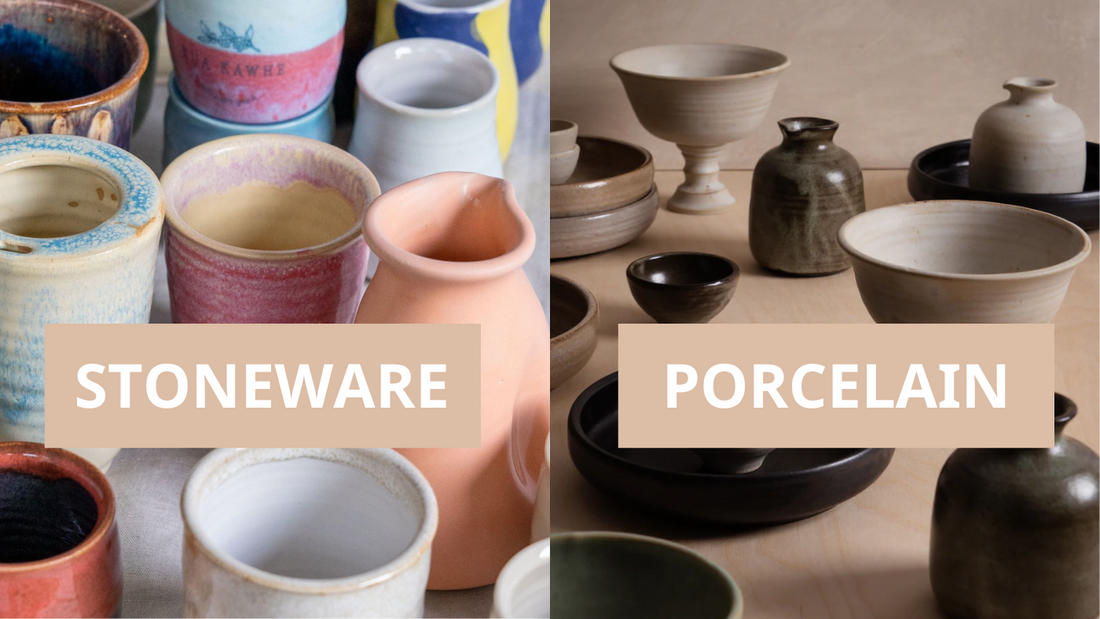Should you choose stoneware or porcelain for your dinnerware? Both materials have their own unique characteristics that make them suitable for different purposes. Let's delve into the differences between stoneware vs porcelain to help you make an informed choice.
Understanding Stoneware
What Is Stoneware?
Stoneware is an extremely durable, dense clay body that, when fired, takes on the texture of stone or rock. Stoneware is a perfect material to make tableware and other drinking and eating vessels because it is less porous than earthenware.
The gray-colored clay from which stoneware is typically fired in a kiln between 2,000 and 2,300 degrees Fahrenheit. Stoneware does not require glazing to become waterproof after it has been fired. The majority of stoneware is dishwasher and microwave-safe.

Advantages of Stoneware
- Durability: Stoneware is one of the oldest dinnerware. The added moisture and inherent elasticity of the clay allow stoneware to withstand more wear and tear.
- Cost-Efficient and Affordable: Due to the clay and additives are easy and cheap to source, in addition, stoneware requires less intense firing which makes it a more affordable choice.
- High Heat Threshold: Stoneware can hold heat exceptionally well and heats up quickly.
Considerations of Stoneware
While stoneware is a great choice for some applications, it’s not always the best choice because it can be hard to clean, absorb, and scratch other surfaces. Here are some factors to consider before opting for this material.
- Coarse Texture: Stoneware has a coarse grain, making its appearance unrefined and rough. In addition, sponges, rags, and bits of food can get caught in these pores, so stoneware can be difficult to clean.
- Absorbent Material: It is porous, and absorbs more moisture than porcelain. This moisture absorbency leads to a softer finished product than can hold bacteria.
- Rough Bottom: Stoneware has a rough bottom. The bottom can't be applied glaze because it will fuse to the kiln, so the rough, coarse-grained clay is exposed and can scratch countertops, tables, or other dinnerware and bakeware.
Understanding Porcelain
What is Porcelain?
Porcelain is a type of traditional ceramic that’s long been prized for its smooth, creamy finish and lasting power. Porcelain is made up of a kaolin clay base, with feldspar and quartz silica mixed in to reinforce it, this mixture is fired at around 2300F (while stoneware is fired at about 2100F).

Let's continue to read the articles to dive into porcelain dinnerware pros and cons
Advantages of Porcelain
Porcelain is fired at a higher temperature than stoneware, so it's harder, more durable, and much less likely to break.
- Lightweight Build: Porcelain can be pulled thinner without compromising the integrity of the clay. So that it tends to be lighter and less cumbersome while still retaining its strength. Porcelain bakeware is much easier to maneuver and lift in or out of the oven.
- Smooth Texture: Porcelain is made with a type of clay that has a much finer grain. So that once it’s fired, porcelain has a smoother texture that’s both easier to clean and has a more visually appealing and non-stick finish.
- Thermal-Shock Resistant: Porcelain is thermal-shock resistant so it can deal with all types of temperature fluctuations without cracking or breaking.
Considerations of Porcelain
Here are some considerations to consider when shopping for or using porcelain.
- Easy to Chipping: Porcelain lacks tensile strength, it’s not so great at handling a shock like being put down hard on a counter or bumping into a hard corner. This can often cause chipped corners or bottoms.
- Price: Porcelain has a higher upfront price than ceramic or stoneware.
Stoneware Vs Porcelain: What Are The Differences?
Here's a table comparing the differences between porcelain and stoneware:
|
Aspect |
Porcelain |
Stoneware |
|
Composition |
Made from kaolin clay, feldspar, and quartz. |
Made from various types of clay and minerals. |
|
Appearance |
Translucent and smooth surface. |
Opaque with a range of textures and finishes. |
|
Durability |
Highly durable and resistant to chipping. |
Durable but may be more prone to chipping and cracking. |
|
Density |
Dense and lightweight. |
Dense and heavier compared to porcelain. |
|
Heat Conductivity |
Excellent heat retention and even heating. |
Good heat retention but may have slightly uneven heating. |
|
Glaze Compatibility |
Compatible with a wide range of glazes. |
Compatible with various glazes and finishes. |
|
Price Range |
Generally more expensive. |
Often more affordable compared to porcelain. |
|
Versatility |
Suitable for formal occasions and everyday use. |
Versatile and available in various styles and designs. |
|
Maintenance |
Resistant to staining and easy to clean. |
May require more care and attention for maintenance. |
Is Porcelain or Stoneware Better?
Porcelain is the best option for bakeware, while stoneware would look great on a decorative fruit bowl or memento mug. Porcelain is the only option for bakeware that meets all of the requirements of the best bakeware, including being strong, functional at high oven temperatures, and aesthetically pleasing.




